Efficiency
- Press O or Escape for overview mode.
- Press the copy icon on the upper right of code blocks to copy the code
Class outline:
- Exponentiation
- Orders of Growth
- Memoization
Exponentiation
Exponentiation approach #1
Based on this recursive definition:
$$\begin{equation*} b^n= \begin{cases} 1 & \text{if } n = 0 \\ b \cdot b^{(n-1)} & \text{otherwise} \\ \end{cases} \end{equation*}$$
def exp(b, n):
if n == 0:
return 1
else:
return b * exp(b, n-1)
How many calls are required to calculate exp(2, 16)? 17
Can we do better?
Exponentiation approach #2
Based on this alternate definition:
$$\begin{equation*} b^n= \begin{cases} 1 & \text{if } n = 0 \\ (b^{\frac{1}{2}n})^2 & \text{if $n$ is even} \\ b \cdot b^{(n-1)} & \text{if $n$ is odd} \\ \end{cases} \end{equation*}$$
square = lambda x: x * x
def exp_fast(b, n):
if n == 0:
return 1
elif n % 2 == 0:
return square(exp_fast(b, n//2))
else:
return b * exp_fast(b, n-1)
How many calls to calculate exp_fast(2, 16)? 6
Some algorithms are more efficient than others!
Orders of Growth
Common orders of growth
One way to describe the efficiency of an algorithm according to its order of growth, the effect of increasing the size of input on the number of steps required.
| Order of growth | Description |
|---|---|
| Exponential growth | Number of steps increases faster than a polynomial function of the input size. |
| Quadratic growth | Number of steps increases in proportion to the square of the input size. |
| Linear growth | Number of steps increases in direct proportion to the input size. |
| Logarithmic growth | Number of steps increases proportionally to the logarithm of the input size. |
| Constant growth | Always takes same number of steps, regardless of input size. |
Adding to the front of linked list
def insert_front(linked_list, new_val):
"""Inserts new_val in front of linked_list, returning new linked list.
>>> ll = Link(1, Link(3, Link(5)))
>>> insert_front(ll, 0)
Link(0, Link(1, Link(3, Link(5))))
"""
return Link(new_val, linked_list)
How many operations will this require for increasing lengths of the list?
| List size | Operations |
|---|---|
| 1 | 1 |
| 10 | 1 |
| 100 | 1 |
| 1000 | 1 |
Constant time
An algorithm that takes constant time, always makes a fixed number of operations regardless of the input size.
| List size | Operations |
|---|---|
| 1 | 1 |
| 10 | 1 |
| 100 | 1 |
| 1000 | 1 |
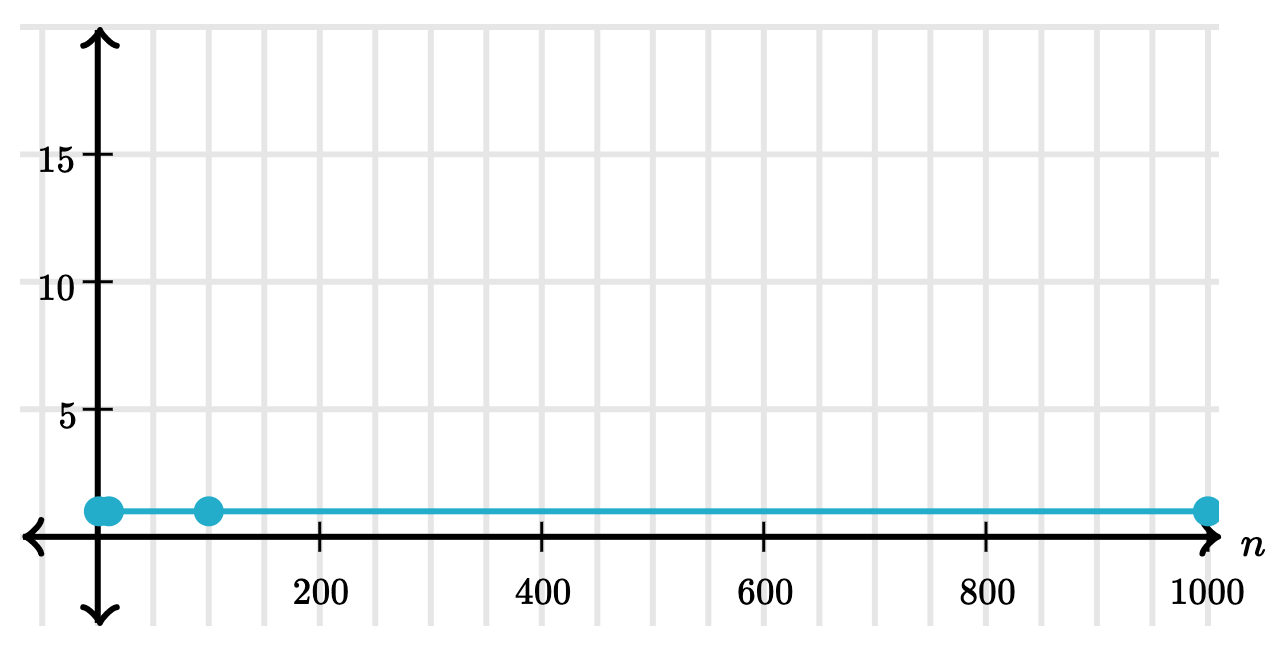
Fast exponentiation
square = lambda x: x * x
def exp_fast(b, n):
if n == 0:
return 1
elif n % 2 == 0:
return square(exp_fast(b, n//2))
else:
return b * exp_fast(b, n-1)
How many operations will this require for increasing values of n?
| N | Operations |
|---|---|
| 0 | 1 |
| 8 | 5 |
| 16 | 6 |
| 1024 | 12 |
Logarithmic time
When an algorithm takes logarithmic time, the time that it takes increases proportionally to the logarithm of the input size.
| N | Operations |
|---|---|
| 0 | 1 |
| 8 | 5 |
| 16 | 6 |
| 1024 | 12 |

Finding value in a linked list
def find_in_link(ll, value):
"""Return true if linked list ll contains value.
>>> find_in_link(Link(3, Link(4, Link(5))), 4)
True
>>> find_in_link(Link(3, Link(4, Link(5))), 7)
False
"""
if ll is Link.empty:
return False
elif ll.first == value:
return True
return find_in_link(ll.rest, value)
How many operations will this require for increasing lengths of the list? Consider both the best case and worst case.
| List size | Best case: Operations | Worst case: Operations |
|---|---|---|
| 1 | 1 | 1 |
| 10 | 1 | 10 |
| 100 | 1 | 100 |
| 1000 | 1 | 1000 |
Linear time
When an algorithm takes linear time, its number of operations increases in direct proportion to the input size.
| List size | Worst case: Operations |
|---|---|
| 1 | 1 |
| 10 | 10 |
| 100 | 100 |
| 1000 | 1000 |
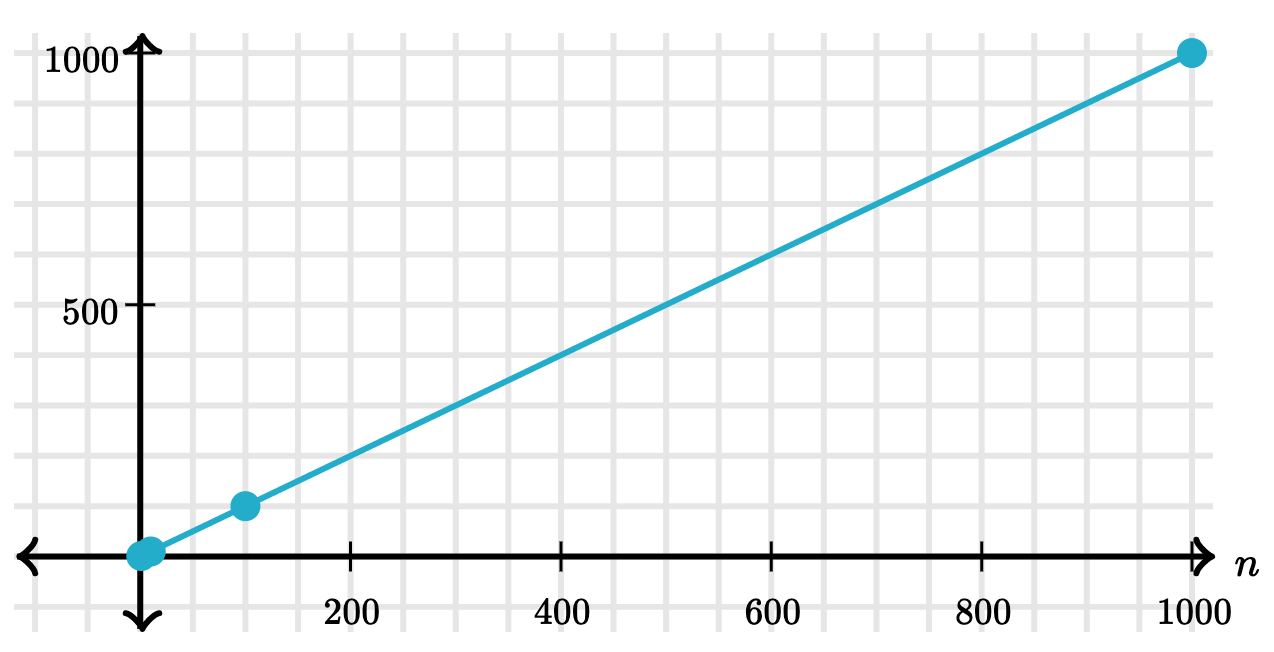
Counting overlapping items in lists
def overlap(a, b):
"""
>>> overlap([3, 5, 7, 6], [4, 5, 6, 5])
3
"""
count = 0
for item in a:
for other in b:
if item == other:
count += 1
return count
| 3 | 5 | 7 | 6 | |
|---|---|---|---|---|
| 4 | ||||
| 5 | + | |||
| 6 | + | |||
| 5 | + |
How many operations are required for increasing lengths of the lists?
| List size | Operations |
|---|---|
| 1 | 1 |
| 10 | 100 |
| 100 | 10000 |
| 1000 | 1000000 |
Quadratic time
When an algorithm grows in quadratic time, its steps increase in proportion to square of the input size.
| List size | Operations |
|---|---|
| 1 | 1 |
| 10 | 100 |
| 100 | 10000 |
| 1000 | 1000000 |
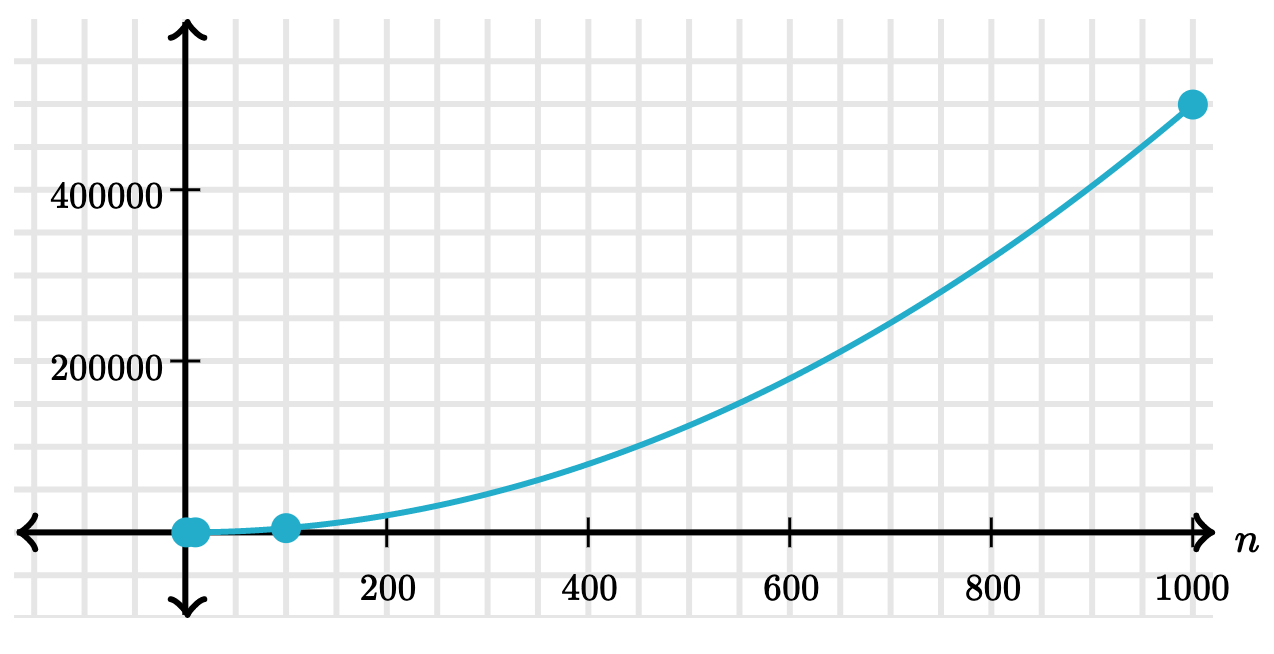
Recursive Virahanka-Fibonacci
def virfib(n):
if n == 0:
return 0
elif n == 1:
return 1
else:
return virfib(n-2) + virfib(n-1)
How many operations are required for increasing values of n?
| N | Operations |
|---|---|
| 1 | 1 |
| 2 | 3 |
| 3 | 5 |
| 4 | 9 |
| 7 | 41 |
| 8 | 67 |
| 20 | 21891 |
Exponential time
When an algorithm grows in exponential time, its number of steps increases faster than a polynomial function of the input size.
| N | Operations |
|---|---|
| 1 | 1 |
| 2 | 3 |
| 3 | 5 |
| 4 | 9 |
| 7 | 41 |
| 8 | 67 |
| 20 | 21891 |
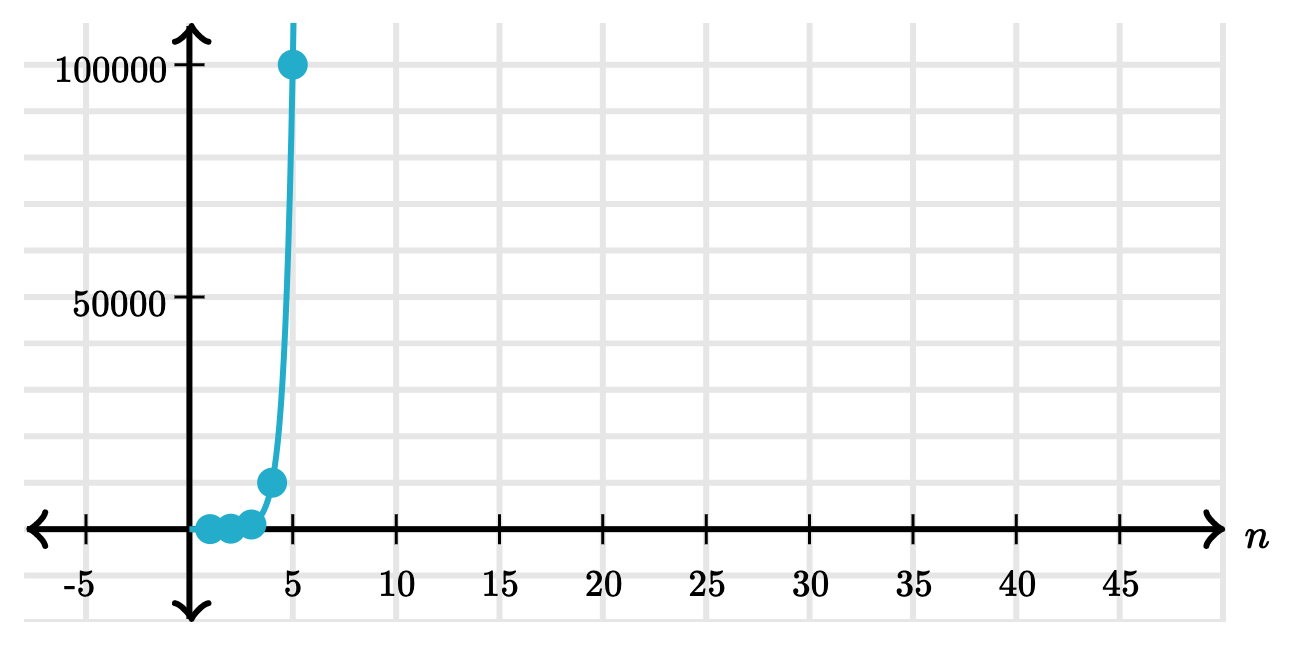
Comparing orders of growth
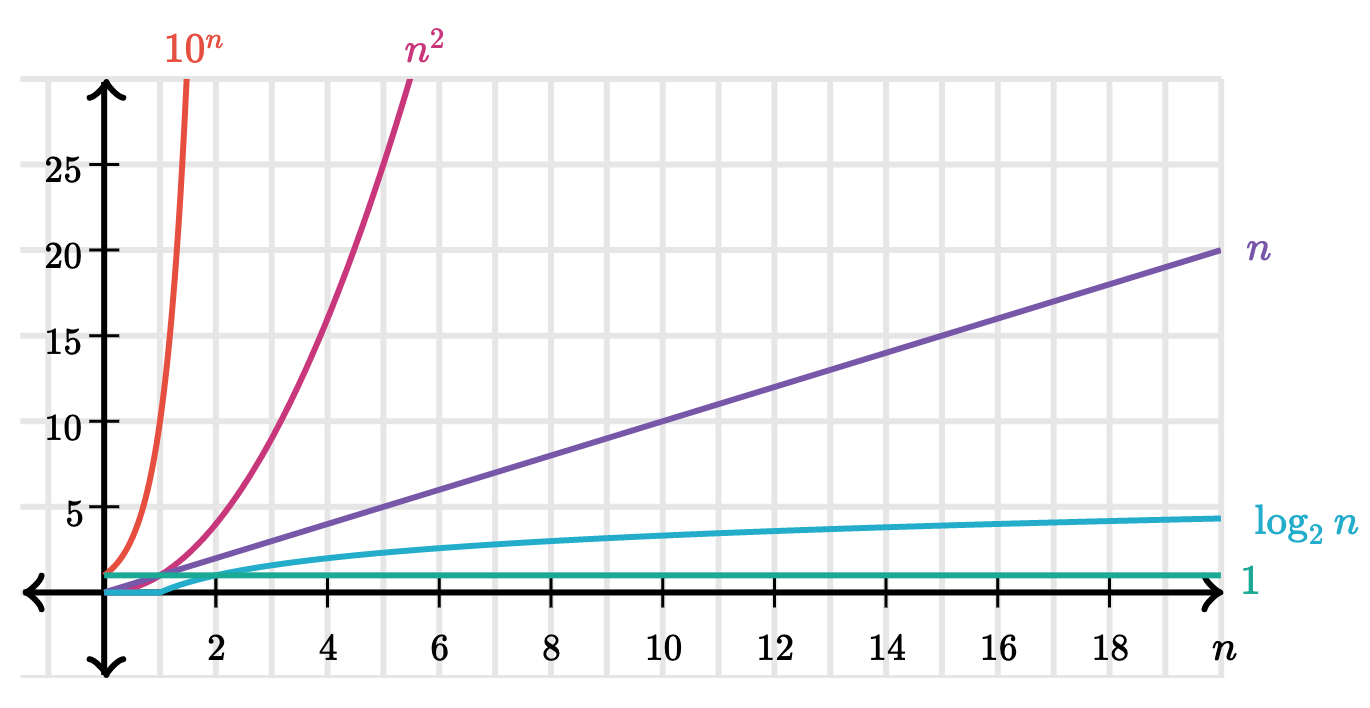
Big O Notation
A formal notation for describing the efficiency of an algorithm, using asymptotic analysis.
| Order of growth | Example | Big O |
|---|---|---|
| Exponential growth | recursive virfib |
$$O(b^n)$$ |
| Quadratic growth | overlap |
$$O(n^2)$$ |
| Linear growth | find_in_link |
$$O(n)$$ |
| Logarithmic growth | exp_fast |
$$O(\log n)$$ |
| Constant growth | add_to_front |
$$O(1)$$ |
Space
Space and environments
The space needed for a program depends on the environments in use.
At any moment there is a set of active environments.
Values and frames in active environments consume memory.
Memory that is used for other values and frames can be recycled.
Active environments:
- Environments for any function calls currently being evaluated.
- Parent environments of functions named in active environments.
Active environments in PythonTutor
def virfib(n):
if n == 0:
return 0
elif n == 1:
return 1
else:
return virfib(n-2) + virfib(n-1)
View in PythonTutor
Make sure to select "don't display exited functions".
Visualization of space consumption
Memoization
Memoization
Memoization is a strategy to reduce redundant computation by remembering the results of previous function calls in a "memo".
A memoization HOF
def memo(f):
cache = {}
def memoized(n):
if n not in cache:
cache[n] = f(n)
return cache[n]
return memoized
Memoizing Virahanka-Fibonacci
| nn | Original | Memoized |
|---|---|---|
| 5 | 15 | 9 |
| 6 | 25 | 11 |
| 7 | 41 | 13 |
| 8 | 67 | 15 |
| 9 | 109 | 17 |
| 10 | 177 | 19 |